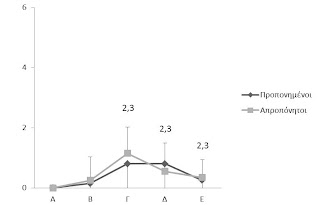 |
| A snapshot from the presentation. |
Plyometric training is widely used in athleticism and has been linked with benefits in anaerobic performance such as speed, agility and explosiveness. The stretch shortening cycle is a prerequisite of plyometric exercises, a basic component for power production, which, due to the intense activation of the motor units of the muscle, is possible to cause exercise induced muscle damage, which in turn can cause a drop in performance for many hours or days after the exercise bout.
The purpose the study was to evaluate the effect of a high intensity plyometric bout of lower extremities, which is being used widely on the training process, on indicators of performance and muscle damage on trained and untrained men.
In the study 40 athletes participated that were divided into two groups, after an initial evaluation of their fitness level, based on the safety considerations that have been recommended. The untrained group (20 athletes, Squat RM 109,35 ± 17,21 kg, RM compared to body weight 1,42 ± 0,17, Squat Power 5,35 ± 0,81 repetitions in 5 seconds) and the trained team (20 athletes, Squat RM 151,25 ± 16,53 kg, RM compared to body weight 2,14 ± 0,20, Squat Power 5,90 ± 1,02 repetitions in 5 seconds), participated in a high intensity plyometric bout.
The rating of perceived soreness in the DOMS scale, thigh circumferences, knee range of motion, squat jump, countermovement jump and drop jump were the dependent variables, that were tested before the plyometric bout, right after, as well as 24, 48 and 72 hours later.
Data analysis presented significant differences of muscle injury indicators, DOMS: +11,5% and +8%, Circumferences: +1.35% and +1.37%, Knee Joint Range of Motion: -0.55% and -0.03% and significant changes in performance indicators, Squat Jump: -7.2% and -7.4%, Countermovement Jump: -7.6% and -5.2%, Drop Jump: -8% and -10.5%, for untrained and trained respectively.
Data analysis presented significant differences of muscle injury indicators, DOMS: +11,5% and +8%, Circumferences: +1.35% and +1.37%, Knee Joint Range of Motion: -0.55% and -0.03% and significant changes in performance indicators, Squat Jump: -7.2% and -7.4%, Countermovement Jump: -7.6% and -5.2%, Drop Jump: -8% and -10.5%, for untrained and trained respectively.
Here are the diagrams for muscle damage indicators.
Symbols : Rhombus trained, square untrained.
1: Differences between groups.
2. Significant differences of trained group compared with the initial values.
3. Significant differences of untrained group compared with the initial values.
 |
| Knee Joint Range of Motion |
Here are the diagrams for performance indicators.
 |
| Drop Jump |
In conclusion, the results showed that the trained group, in relation with the strength, had less muscle damage and better performance than the untrained in almost all the time points during recovery period.





